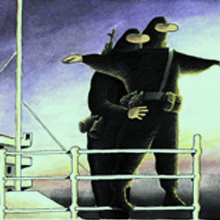
Kiev, la capital de Ucrania, fue la primera capital de los Russ, los vikingos del norte que colonizaron las tierras del Volga y que dieron su nombre al pueblo que aún vive en la actualidad. Moscov fue fundado más tarde por un disidente de Southern Russ. Así, si todos son Russ, no todos se sienten rusos, dividiéndose ese vasto territorio en distintas naciones y «pueblos». Esta convivencia y enfrentamientos dan como resultado la guerra actual que desestabiliza a Occidente.
Ucrania es el país de la antigua URSS con los dibujantes más activos, participando intensamente en Festivales Internacionales con mucha calidad estética y humorística. Sin embargo, ¿esta viva fuerza del humor refleja un país lleno de humor, libertad de expresión y una prensa rica en cartoons?
Para conocer mejor esta realidad, hablamos con el dibujante Konstantin Kazanchev: «En realidad, en Ucrania, el panorama de la caricatura es malo. Pocos sitios publican y cuando lo hacen, es como una ilustración para un artículo, no como una caricatura editorial. Por supuesto, puedes publicar libremente en Internet, pero no te pagan por ese trabajo».
Pero aun así, hay muchos artistas trabajando en este campo. «Sí, tenemos dibujantes, caricaturistas que logran ganar algo de dinero, pero no lo suficiente para sobrevivir, entonces hacen otros trabajos en paralelo. Sin embargo, en Ucrania, la libertad de expresión, los derechos humanos tampoco pasan por buenos momentos. Por eso los artistas tienen que tener mucho cuidado, no se arriesgan, se autocensuran mucho. Incluso el gobierno alienta a los elementos radicales, que no toleran opiniones distintas a las propias, a castigar a los que están en la oposición. Es decir, hay mucha intolerancia a la crítica y al humor de oposición».
¿Siempre fue así? ¿Cómo es la historia del humor gráfico en Ucrania? «La historia del humor en Ucrania está íntimamente ligada a la historia del humor en el Imperio Ruso con todas sus vicisitudes de opresión y libertades. Sin embargo, en comparación con Rusia, Ucrania es más conservadora, grosera, e incluso hay un dicho nuestro que dice: "Si en Moscú se cortan las uñas, en Kiev se cortan los dedos".
Había revistas humorísticas y periódicos que publicaban humor antes de la revolución bolchevique e incluso durante esos años revolucionarios del 18 al 21 había prensa de panfletos de todas las facciones. Durante el régimen soviético desapareció la mayor parte de la prensa independiente, pero cada una de las repúblicas tenía su diario humorístico oficial (había 15). En Ucrania fue "Peretz". Entonces había caricaturas en todas las publicaciones, pero ahora ya no es así. La sociedad se ha vuelto mucho más oscura de lo que era durante la era soviética. Ha crecido una generación que no conoce el cartoon “sin palabras”, que no sabe leer el humor más sutil».
¿Se puede decir que hay un humor especial en Ucrania? ¿Existen diferencias entre las zonas rurales y urbanas? «No creo que sea diferente, porque el humor es universal pero en realidad hay diferencias entre el campo y la ciudad en la comprensión del cómic. El humor rural es más crudo y sencillo, como ocurre en todo el mundo. El humor del país ucraniano toca los problemas de supervivencia, los beneficios que puede tener. Es un humor sencillo, como su ropa, con especiales trucos cómicos de complicidad rural, pero siempre de forma sencilla, mientras que la de la ciudad, como la ropa más sofisticada, es más refinada. En la ciudad el humor tiene más oportunidades creativas, tiene un mayor nivel cultural, porque aquí hay más posibilidades de obtener más información, por lo tanto más rica y sutil».
El humor de un pueblo no es sólo caricatura. ¿En qué género artístico se expresa mejor el humor ucraniano? «El humor es un arte universal en todos los géneros, ya sea en la música, el teatro o incluso la publicidad. Creo que si un cantante no tiene algunas canciones divertidas en su repertorio, no tendrá éxito ni será popular. La risa (como consecuencia del humor) es un poderoso remedio para la depresión y el estrés».
¿Cómo ha sido tu camino como artista? «Mi primer trabajo publicado en prensa fue en 1982. Nunca pude trabajar en un periódico como parte de los editores, siempre fui freelance. Gané mucho dinero, pero solo durante la época soviética. Después del colapso de la URSS empeoró año tras año hasta que hoy es realmente malo. Pero creo que esta es la tendencia mundial, con periódicos que se deshacen de las caricaturas. Pero aun así realizo exposiciones (más de 50) y participo en Festivales Internacionales, pero las autoridades lamentablemente no nos apoyan. Ya he participado en 31 concursos (21 internacionales y 11 ucranianos) en los que ya he obtenido 131 premios. Así que no me puedo quejar demasiado…”
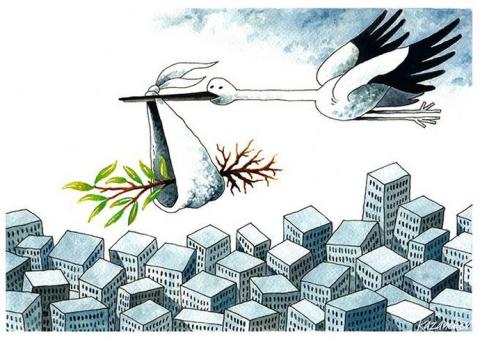
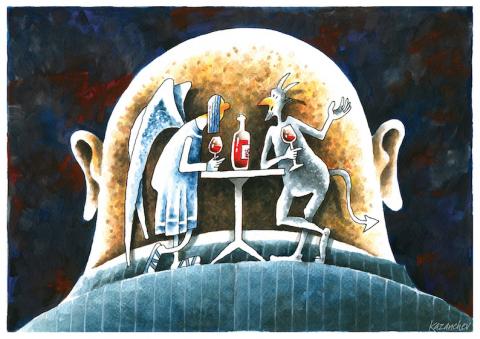
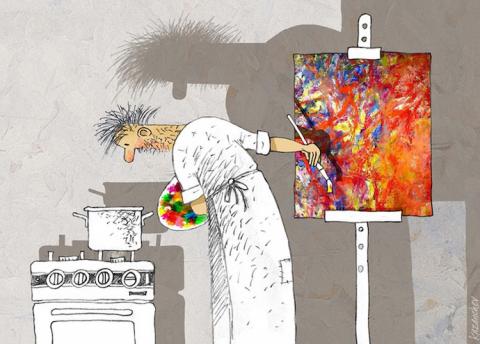
Humores de Guerra
Dice el refrán que «en tiempo de guerra no limpiamos las armas», juicio que parece erróneo porque es precisamente en esos momentos cuando hay que tenerlo todo bien limpio y engrasado, para no perder el blanco a atacar y una de esas armas es el humor, la sátira. El humor en la guerra se puede dividir en dos frentes: panfleto y entretenimiento.
Incluso podemos decir que, en parte, el caricaturista nació de esta necesidad de luchar por las causas. Esto ocurría en tiempos de la «Reforma», la «Revolución Francesa», «Liberal»... o en las «Grandes Guerras» y pequeñas guerras de la vida cotidiana. Los artistas que siguieron esta línea lo hacen como «misioneros» de una causa (personal, partidista, nacional...) o por encargo, como sucedió en las campañas de información y contrainformación de las Guerras Mundiales.
La misión del caricaturista, como reportero de guerra que es, es precisamente estar siempre en una posición de ataque contra cualquier poder, es decir, ser un centinela contra gobiernos y oposiciones para no ser acusado de parcialidad. Si por un lado es un guerrillero que siempre está luchando, debe serlo no para suscitar conflictos sino para señalar errores, denunciar violaciones, abusos y orientar a los políticos hacia la paz, hacia el equilibrio político y social del planeta.
Un símbolo importante de esta lucha es la existencia de la asociación (Fundación) «Cartooning for Peace» (creada por Plantu y Kofi Annan como Secretario General de la ONU en 2006) que reúne a artistas de todo el mundo que luchan por esta causa. .
El otro frente, llamado entretenimiento, es un aspecto farmacológico, homeopatía terapéutica para superar traumas, para dar alas al espíritu en la supervivencia del día a día. Los periódicos de trinchera/cuartel son uno de los mejores ejemplos de esta necesidad existencial. En la misma línea, cómicos que luchan en los frentes hospitalarios (auténticos campos de batalla contra la muerte) o en los territorios destruidos de países en conflicto como Siria, Afganistán... Símbolos de esta fuerza/coraje/devoción - misión de repartir sonrisas de esperanza están, entre muchos otros, el sirio Anas Al-Basha (El Payaso de Alepo asesinado en diciembre de 2016) o el afgano Karim Asir que se queda en tierra, por no hablar de los muchos monólogos que trabajan en países casi imposibles. Son seres especiales, con una misión trascendental pocas veces reconocida. Son guerrilleros por la paz, por la luz más humana que pueda existir en el alma de este llamado animal racional, cuando en realidad es con demasiada frecuencia irracional.
Sin embargo, en ambos frentes hay aspectos que pueden impactar a una audiencia que no ha vivido estos momentos, que no comprende realmente el significado y la necesidad de este mensaje. A estos les surge la pregunta: ¿Se puede bromear, hacer humor, satirizar la muerte, los horrores, la violencia de la guerra? Por supuesto, en sí mismo, no hay nada de gracioso en este horror, sin embargo, saber que uno puede sobrevivir en este mundo absurdo es suficiente para sonreír, por lo que a veces es obligatorio que aquellos que han estado allí sepan reírse de este horror, con horror.
Es en la deconstrucción de los horrores, en la incongruencia de lo inevitable, en el enfrentamiento con la realidad, donde se encuentra el ridículo de la acción humana. Es en ese gesto catártico, reírse de este ridículo en busca de la luz de la esperanza en una sonrisa que los veteranos muchas veces logran salir del oscuro túnel, encontrar el lado terapéutico de este humor, lo mismo que puede pasar con el general público, encontrando así las defensas inmunes contra este mundo absurdo e ilógico. No a través del humor masoquista o sádico, sino a través de la redención humorística.
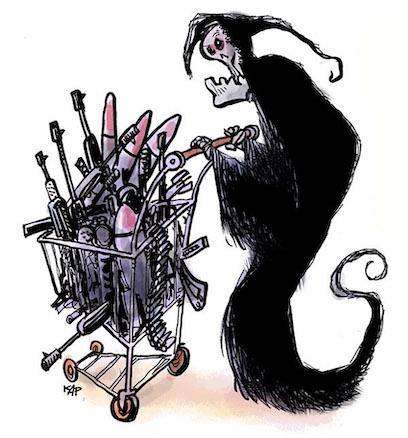
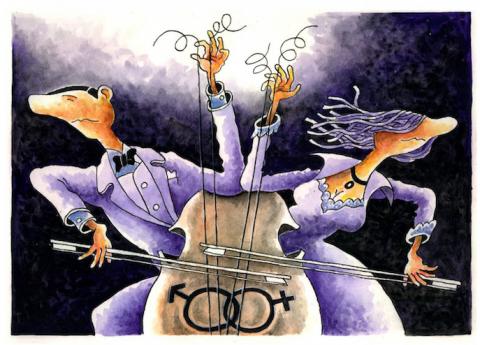
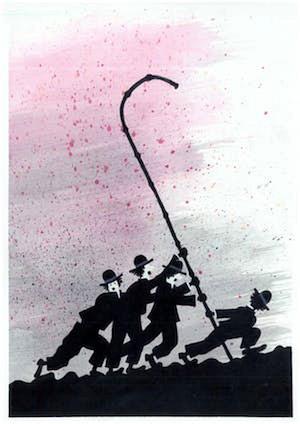
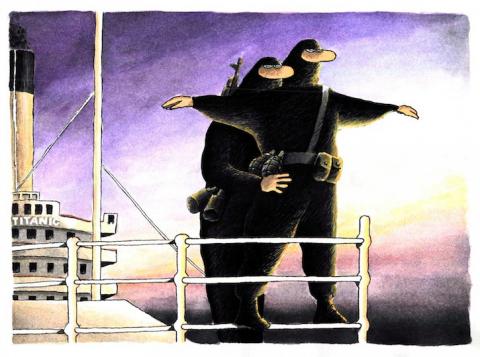
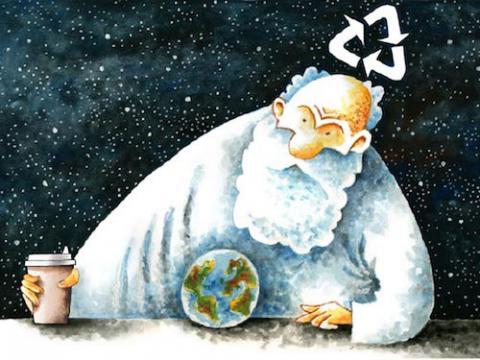
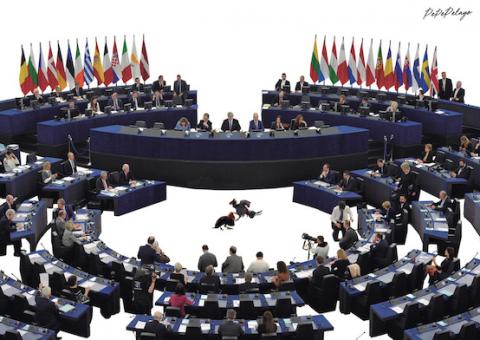
Kyiv, the capital of Ukraine, was the first capital of the Russ, the Vikings from the north who colonized the Volga lands and gave their name to the people who still live today. Moscov was later founded by a Southern Russ dissident. Thus, if everyone is Russ, not everyone feels Russian, dividing that vast territory into different nations and "peoples". This coexistence and confrontations result in the current war that destabilizes the West.
Ukraine is the country of the former USSR with the most active cartoonists, participating intensely in International Festivals with great aesthetic and humorous quality. However, does this living force of humor reflect a country full of humor, freedom of expression and a press rich in cartoons?
To better understand this reality, we spoke with cartoonist Konstantin Kazanchev: «Actually, in Ukraine, the cartoon scene is bad. Few sites publish and when they do, it's like an illustration for an article, not an editorial cartoon. Of course, you can freely publish on the Internet, but you do not get paid for that work.
But still, there are many artists working in this field. «Yes, we have cartoonists, cartoonists who manage to earn some money, but not enough to survive, so they do other jobs in parallel. However, in Ukraine, freedom of expression, human rights are not going through good times either. That's why artists have to be very careful, they don't take risks, they self-censor a lot. Even the government encourages radical elements, who do not tolerate opinions other than their own, to punish those in opposition. That is, there is a lot of intolerance to criticism and opposition humor.
It was always like this? How is the history of graphic humor in Ukraine? «The history of humor in Ukraine is closely linked to the history of humor in the Russian Empire with all its vicissitudes of oppression and freedom. However, in comparison with Russia, Ukraine is more conservative, rude, and there is even our saying: "If in Moscow they cut their nails, then in Kiev they cut their fingers."
There were humor magazines and newspapers publishing humor before the Bolshevik revolution and even during those revolutionary years 18-21 there were pamphlet presses from all factions. During the Soviet regime most of the independent press disappeared, but each of the republics had its official humorous newspaper (there were 15). In Ukraine it was "Peretz". Then there were cartoons in all the publications, but now it is not like that anymore. Society has become much darker than it was during the Soviet era. A generation has grown that does not know the cartoon "without words", that does not know how to read the most subtle humor ».
Can it be said that there is a special humor in Ukraine? Are there differences between rural and urban areas? «I don't think it's different, because humor is universal but in reality there are differences between the countryside and the city in the understanding of comics. Rural humor is cruder and simpler, as is the case all over the world. The humor of the Ukrainian country touches on the problems of survival, the benefits that it can have. It is a simple humor, like his clothes, with special comic tricks of rural complicity, but always in a simple way, while that of the city, like the most sophisticated clothes, is more refined. In the city, humor has more creative opportunities, it has a higher cultural level, because here there are more possibilities to obtain more information, therefore richer and more subtle».
The humor of a people is not just caricature. In which artistic genre is Ukrainian humor best expressed? «Humor is a universal art in all genres, be it in music, theater or even advertising. I think if a singer doesn't have some fun songs in their repertoire, they won't be successful or popular. Laughter (as a consequence of humor) is a powerful remedy for depression and stress.
How has your path as an artist been? «My first job published in the press was in 1982. I could never work in a newspaper as part of the editors, I was always freelance. I made a lot of money, but only during Soviet times. After the collapse of the USSR it got worse year by year until today it is really bad. But I think this is the global trend, with newspapers getting rid of cartoons. But even so, I hold exhibitions (more than 50) and participate in International Festivals, but unfortunately the authorities do not support us. I have already participated in 31 competitions (21 international and 11 Ukrainian) in which I have already won 131 prizes. So I can't complain too much..."
War humor
The saying goes that "in wartime we do not clean our weapons", a judgment that seems wrong because it is precisely in those moments when you have to have everything clean and oiled, so as not to lose the target to attack and one of those weapons is humor , the satire. Humor in war can be divided into two fronts: pamphleteering and entertainment.
We can even say that, in part, the cartoonist was born from this need to fight for causes. This happened in times of the "Reformation", the "French Revolution", "Liberal"... or in the "Great Wars" and small wars of everyday life. The artists who followed this line do so as "missionaries" for a cause (personal, partisan, national...) or commissioned, as happened in the information and counter-information campaigns of the World Wars.
The mission of the cartoonist, as a war reporter that he is, is precisely to always be in a position of attack against any power, that is, to be a sentinel against governments and oppositions so as not to be accused of partiality. If on the one hand he is a guerrilla who is always fighting, he must be so not to provoke conflicts but to point out errors, denounce violations, abuses and guide politicians towards peace, towards the political and social balance of the planet.
An important symbol of this fight is the existence of the association (Foundation) "Cartooning for Peace" (created by Plantu and Kofi Annan as UN Secretary General in 2006) that brings together artists from all over the world who fight for this cause. .
The other front, called entertainment, is a pharmacological aspect, therapeutic homeopathy to overcome traumas, to give wings to the spirit in day-to-day survival. The trench/barracks newspapers are one of the best examples of this existential necessity. Along the same lines, comedians who fight on the hospital fronts (true battlefields against death) or in the destroyed territories of countries in conflict such as Syria, Afghanistan... Symbols of this strength/courage/devotion - mission to spread smiles of hope are, among many others, the Syrian Anas Al-Basha (The Clown of Aleppo murdered in December 2016) or the Afghan Karim Asir who stays on the ground, not to mention the many monologues that work in almost impossible countries. They are special beings, with a transcendental mission rarely recognized. They are guerrillas for peace, for the most human light that can exist in the soul of this so-called rational animal, when in reality it is too often irrational.
However, on both fronts there are aspects that can impact an audience that has not lived through these moments, that does not really understand the meaning and necessity of this message. The question arises for them: can you joke, make humor, satirize death, the horrors, the violence of war? Of course, in itself, there is nothing funny about this horror, however, knowing that one can survive in this absurd world is enough to make one smile, so it is sometimes obligatory for those who have been there to know how to laugh at this. horrified, horrified
It is in the deconstruction of horrors, in the incongruity of the inevitable, in the confrontation with reality, where the ridicule of human action is found. It is in this cathartic gesture, laughing at this ridicule in search of the light of hope in a smile that veterans often manage to get out of the dark tunnel, find the therapeutic side of this humor, the same thing that can happen with the general public, thus finding immune defenses against this absurd and illogical world. Not through masochistic or sadistic humor, but through humorous redemption.
